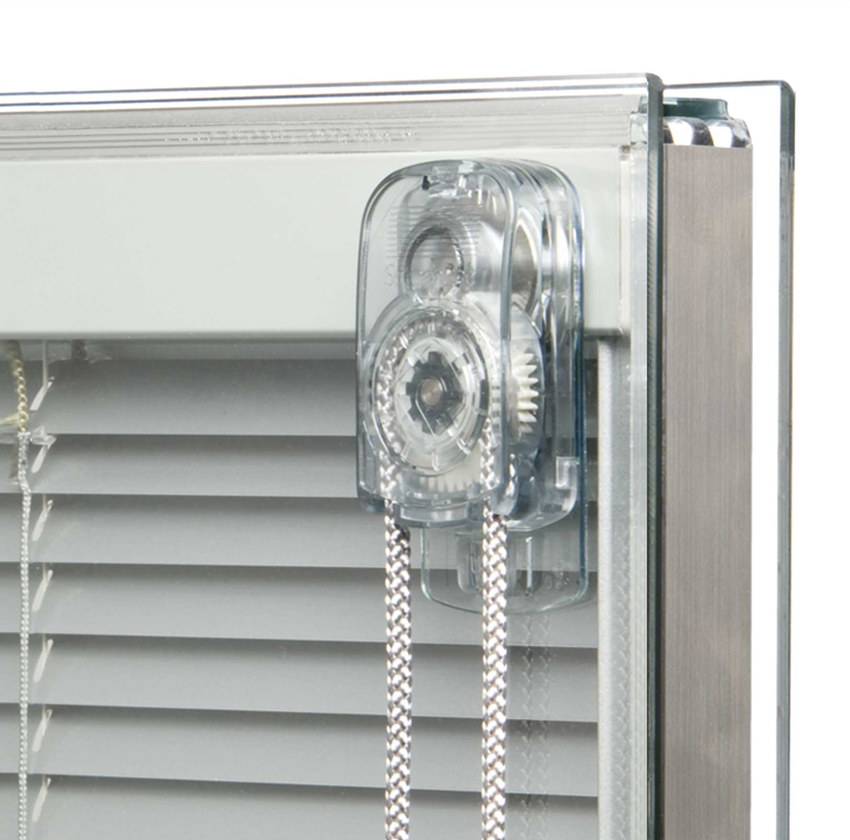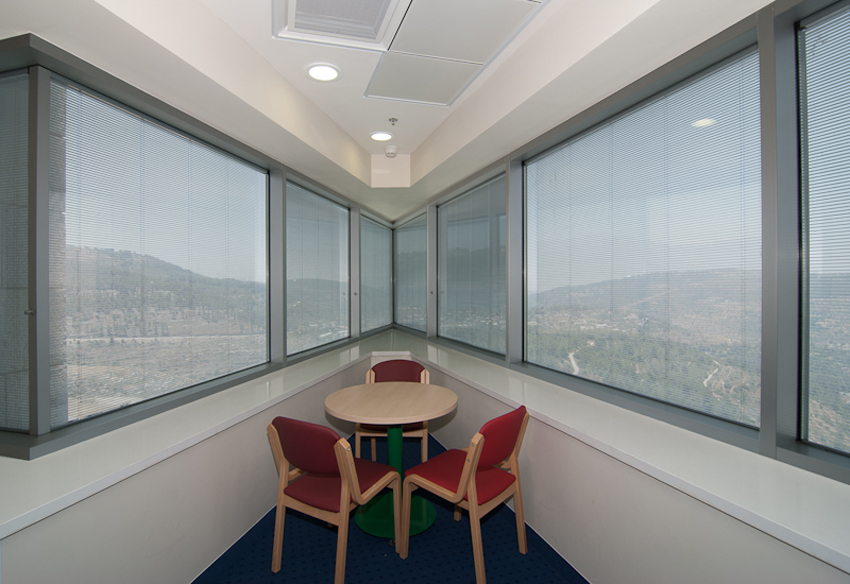Built-In Blinds
BBG Options
Overall, when comparing BBGs to conventional blinds, Donovan points out that the latter are susceptible to damage, prone to collecting dust, and have limited aesthetic appeal. Donovan is impressed with the benefits of BBG systems, namely better IAQ, reduced maintenance, and durability. Conventional blinds are known to become brittle and break over time, thereby requiring replacement as frequently as every four years. On the contrary, BBGs have the potential to last as long as the windows themselves.
“Accessible controls were a high priority,” Martinez-Wyat adds. “Other non-BBG shading options fall short on accessible controls. With BBGs, even when blinds are randomly drawn, the facade has a more uniform look as the system always covers the full height of each window lite.”
Based on application and user preference, operational systems include the following:
Cord-operated external magnetic device. Two coupled rotational magnetic devices operate the system. One set of magnets is located inside the blind head rail within the cavity, and the other is applied to the external glass surface. This way the integrity of the insulating glass is preserved. A cord loop is used to raise and lower the blinds, and in venetian models, tilting. Electric operation is also available by replacing the external magnetic device with an external motor.

Photo courtesy of Pellini SpA
Two rotational magnetic devices, one inside the cavity and one on the external glass surface, operate this integrated blinds system.
Motorized battery-operated with solar panel. The motorized raising/lowering and tilting functions via a battery-operated swipe control device that is magnetically attached to the window frame or glass surface. The battery module can be recharged through a micro-USB connector or by electricity, and some manufacturers offer an external solar panel.
Manual operation by sliding magnetic handle.
Manual knob control. This tilt-only venetian blind is operated by an external knob. The specially designed corner key containing the rotational magnet is connected to the external knob by a flexible drive cable located within the glazing cavity of the window frame. Because the only visible control is the external knob fixed to the window frame, this fully frees up the glass surface and makes it easy to clean. Another manual knob control system utilizes two gears located in the top and bottom corner keys of the blind, connected to each other by means of a shaft that is completely concealed inside the spacer bar. The system works well for windowsill applications such as structural facades, as the control device located at the bottom of the blind is more easily accessible and within reach.
Internal motor control. For this system, a brushless motor is incorporated within the head rail. In place of brushes, which are subject to wear and tear, the motor operates by means of a magnetic field. In the absence of electromagnetic interference, the system operates at an extremely low noise level. The brushless technology also enables the blinds to be integrated with the most complex building management system networks and managed via mobile devices.
External brushless motor. The system can be easily applied to frontal magnetic transmission systems and retrofitted to existing cord-operated systems. It allows venetian blinds to be raised/lowered or tilted. Pleated and roller blinds can be raised or lowered.
Evaluating the Marketplace
When selecting a BBG manufacturer to partner with, a number of important factors typically go into this decision. Specifiers will want to look at durability, ease of use, thermal performance, integration with high-performance glazing, color and style selections, manufacturer support, and lead times.
“In our opinion, performance and manufacturer support are the two most important,” Levi asserts. “We are employing BBG as a key element in the building envelope system, and as such, it must stand the test of time, exposed to the elements while subjected to constant use. This being the case, it is best to deal only with firms who have deep knowledge of these systems and a proven track record implementing the technology in the field.”
“While we would never select a product that did not provide the desired functionality or aesthetics, in our experience, the top product lines in the marketplace offer a wide variety of options that have addressed all of our needs,” he adds.
Also, emphasizing the importance of selecting experienced manufacturers, Martinez-Wyatt explains, “I would highly recommend a full-sized mockup of the system as well as utilizing a reputable company with warranties and manufacturer support in place in the event of failure.”
Another plus is working with manufacturers who integrate the blind system with a window product. This way, building teams only have to deal with one supplier and can receive a warranty for the full system.
Many BBG systems are manufactured overseas, which significantly increases lead times. However, by working with companies with domestic manufacturing plants, this can significantly impact project schedules and tight deadlines.
Popular Applications
With hygiene, daylighting, and privacy topping the list of design features sought by health-care projects, BBG can be a great fit.
Pointing out the fact the conventional interior shading fabrics can’t easily be wiped clean or laundered, Levi is a fan of BBG for these applications.
For the Jerusalem Hadassah Davidson Tower project, Spector-Amisor felt that the other non-BBG options did not offer the same level of cleanliness for the patients. Furthermore, the architects were concerned that exposed external shades would be more susceptible to breakage and vandalism.

Photo: Courtesy of Pellini SpA/Tom Kohn

Photo courtesy of Spector-Amisor Architects
Enhanced hygiene, privacy, visual comfort, and low maintenance were the main factors leading Spector-Amisor Architects to specify BBG for the Hadassah Medical Center’s Davidson Hospital Tower in Jerusalem, Israel.
Another advantage proffered by BBGs at the Davidson Tower was the fact that they served the dual purpose of lending privacy both during daylight hours and at night.
“During the day, people do not see into the building as the windows appear black due to the combination of bright sunlight outside, window tinting, and lower light levels on the building interior. As such, the role of the blinds in the day is primarily to control solar glare and modulate light levels,” Levi explains. “However, at night, when people can see into the light rooms from the dark outside, the blinds are used to achieve privacy.”
In addition to the patient rooms, offices, and lounges, BBGs were also designed for areas such as the intensive care units, operating rooms, and staff workspaces.
“In the ICU units, they allow monitoring or vision for staff between patient rooms; in the doors to the operating and isolation rooms, they allow staff to observe inside without violating the sterile environment; and in nurse or doctor workspaces, they provide the staff with the flexibility of choosing a more private work environment or one in which they had greater visual control of their surroundings,” relates Levi.
The architect selected tilt-only blinds with a knob which is connected to the blinds by a steel cable and mounted on the structural aluminum profile, as opposed to a sliding magnet or electronic operation. For this particular application, the owner didn’t want any parts that could be removed or lost. The electronic option would have been too costly for this large tower.









